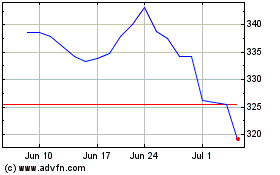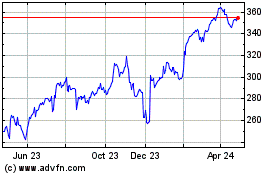Kamala Harris Unveils Plan to Transform Health Care to a Federal System
July 29 2019 - 6:29AM
Dow Jones News
By Stephanie Armour and Tarini Parti
WASHINGTON -- Democratic presidential candidate Sen. Kamala
Harris (D., Calif.) released a plan Monday to reshape the U.S.
health-care system by transforming it over 10 years to a federal
one that would still allow a limited role for private insurers.
Ms. Harris, who has been criticized by some more progressive
members of her party for her lack of clarity on her support for
Medicare for All, released the plan a day before the start of the
second round of Democratic presidential debates, where health care
is expected to be a key topic. In the last debate series in June,
Ms. Harris raised her hand when candidates were asked if they would
abolish private health insurance, but she said the next day she had
misunderstood the question.
Her version of Medicare for All would upend the current system
for a government-run health-care program that would cover a robust
set of benefits, from long-term care to mental health and
hospitalization. But private health plans such as those from Cigna
and Aetna Inc. could offer Medicare Advantage -- in essence, plans
with enhanced benefits.
She also would move people into the program over 10 years
instead of the four that Sen. Bernie Sanders (I., Vt.) has outlined
in his Medicare for All proposal. Ms. Harris's plan proposes to
raise funding revenue with taxes on higher-income families and Wall
Street trades and without raising taxes on the middle class.
"Medicare works. It's popular," Ms. Harris wrote in a post
scheduled to appear Monday morning on the website Medium. "Seniors
transition into it every day, and people keep their doctors and get
care at a lower cost. Let's not lose sight that we have a Medicare
system that's already working."
Democrats fared well in the 2018 midterm elections by portraying
the party as the defender of the Affordable Care Act in the face of
GOP attempts to repeal it. Progressive Democrats are pushing for
Medicare for All, without an option for private insurance, while
centrists argue ripping up the current U.S. health system is overly
aggressive and risks alienating voters.
Ms. Harris's plan would permit Medicare Advantage, which are
plans offered by private carriers that contract with Medicare. But
it would impose new federal regulations aimed at improving plan
quality, cost and access though her campaign didn't disclose
details.
Employers would pay into either Medicare for All or Medicare
Advantage during the transition period to get coverage for their
employees. Medicare Advantage, which has been growing in the last
decade, now accounts for one-third of the 64 million people covered
by Medicare, according to the Kaiser Family Foundation. About one
fifth of Medicare Advantage enrollees are in an employer- or
union-sponsored group plan.
This would be the primary role for private health insurers.
Employers would pay into the new federal program, and workers would
get their coverage from the expanded Medicare program. Many private
insurers currently offer these Medicare Advantage plans. The plans
they would offer under Ms. Harris's health system would be subject
to new requirements and conditions. Currently, some employers offer
Medicare Advantage to older workers; Medicare is now generally a
program for people age 65 and older.
The plan aims to expand health coverage in the U.S., Ms. Harris
said. Under Medicare for All, consumers have out-of-pocket payments
only for prescription drugs. She didn't release details of how her
transition period would work.
Write to Stephanie Armour at stephanie.armour@wsj.com and Tarini
Parti at Tarini.Parti@wsj.com
(END) Dow Jones Newswires
July 29, 2019 06:14 ET (10:14 GMT)
Copyright (c) 2019 Dow Jones & Company, Inc.
Cigna (NYSE:CI)
Historical Stock Chart
From Mar 2024 to Apr 2024

Cigna (NYSE:CI)
Historical Stock Chart
From Apr 2023 to Apr 2024
